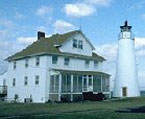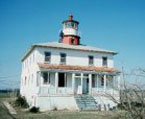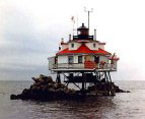Types of Chesapeake Bay Lighthouses
Many methods have been used over the years to mark and illuminate harbors, channels, and hazards. These include simple fires maintained on hillsides, lanterns raised on poles or hung in trees, lighted ships anchored in strategic spots, and various designs of lighthouses. There are 34 lighthouses of the "manned" type still left standing on the Chesapeake Bay. These fall into three very general categories, somewhat dependent on the timeframe in which they were built.
The first and oldest style is land-based. These may be the masonry towers with separate keepers dwelling that most people associate with a lighthouse (e.g. Cove Point Light 6 miles north of the mouth of the Patuxent River), or may simply be houses with a copula for the light and lens built onto the roof (e.g. Point Lookout Light at the northern mouth of the Potomac River). When these were first built (late 1700s onwards), the cost effective technology didn't exist to build structures on the water. Their effectiveness was, therefore, somewhat limited due to their land location. Shore erosion was also a threat. Several shore lights have been moved more than once. Others had to be abandoned and collapsed when the land on which they sat was reclaimed by the Bay.


The next style to emerge on the Bay was the "screwpile" lighthouse (developed in 1850). These were cottages, built on the water, atop iron pilings. A copula with light sat atop the cottage roof. True screwpile pilings have metal flanges and were literally screwed by hand into the mud / sand bottom of a shoal. However, the term was often used generically and some of the Bay screwpile lights sat on pilings that were only driven straight into the bottom and sheaved in iron. These lights were relatively inexpensive to build and so well suited to the Chesapeake Bay that more were built there than any other place in the world. However, they had a tendency of being either damaged or destroyed by ice floes. (On one instance the cottage with its keeper and assistant keeper still inside was swept off its pilings and carried 5 miles before they were able to escape.) Even though 42 screwpile lights were built on the Bay, only 4 are still in existence today. Their light design made them easy to dismantle and many were torn down in the 1960s. Of the remaining four, the most famous, and the only one still in its original location, is Thomas Point Shoal Light off Annapolis, MD. (The remaining three have been moved to museum settings).

In response to both the ice floe problem and a cry for better navigational aids in light of increased steamer and passenger traffic, the final type of manned lighthouse was developed in the late 1800s. The caisson style was constructed of cylinders (usually iron) that were sunk 15 or more feet into the bottom, then filled with cement. A platform was created this way and a tower with sturdy dwelling was built on top of the platform. Some of these are quite beautiful Victorian brick dwellings, while others are simply stark metal towers. These were expensive to build but could be located in deeper waters and more remote locations. All of the caisson lighthouses built on the Bay are still standing. However, one (Sharps Island Light) was tilted fairly badly by heavy ice flows in 1976.


The 20th century brought technology with it that spelled the end to the manned lighthouse era. One by one the structures were automated. While some towers are still used as light platforms (active aids to navigation), many have either been torn down or have fallen into disrepair through neglect, vandalism, and the elements. Lighthouses have a great charm and nostalgia affecting many people. There are a number of groups striving to preserve these historic structures. There have been several successes stories. However, most structures are barely maintaining a constant level of disrepair. Several are so seriously deteriorated that without imminent action their future is uncertain.